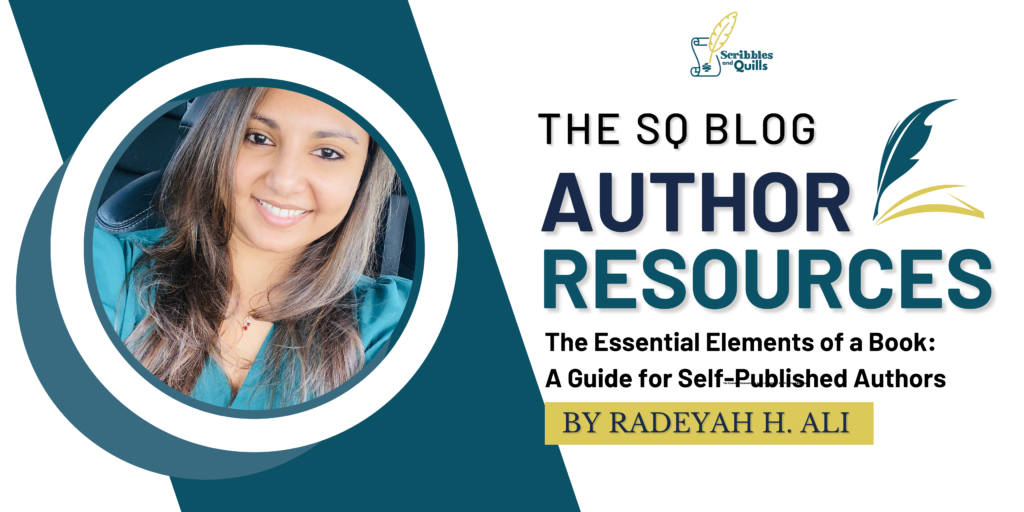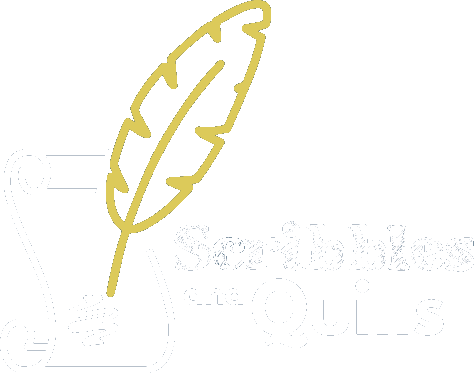The Essential Elements of a Book: A Guide for Self-Published Authors

Written by Radeyah H. Ali
When you set out to self-publish your book, it can be both exciting and overwhelming. Whether you’re an aspiring novelist, a children’s book author, or someone who’s ready to share your expertise, understanding the essential elements of a book is key to producing a professional and engaging final product.
At Scribbles and Quills Limited, we believe in empowering local authors to succeed in their publishing journey. In this post, we’ll break down the core components of a book, from cover design to formatting, so you can create a polished work that resonates with your readers.
1. The Concept & Content
Before diving into the technicalities of publishing, it’s important to focus on the core of your book: the content. Whether you’re writing fiction, non-fiction, or poetry, the heart of your book is the story or message you want to convey.
- Clarity of Purpose: What are you hoping to achieve with your book? Whether it’s to entertain, educate, or inspire, make sure the purpose of your book is clear. Knowing this will guide your writing and help you craft a compelling narrative.
- Engaging Story or Information: Your readers should be drawn into your world from the very first page. Make sure your writing is engaging, your message is clear, and your content is well-researched (if applicable).
- Target Audience: Think about who you’re writing for. Are you targeting young children, teenagers, or adults? Is your book intended for educational purposes or entertainment? Understanding your target audience helps shape both your content and your marketing efforts.
2. Book Structure & Organization
A well-organized book not only improves the reading experience, but it also gives your work a professional touch. Every book has a basic structure, and how you organize your content can vary based on the type of book you’re writing.
- Chapters and Sections: For a novel or narrative-driven work, divide your content into clear chapters or sections. Each chapter should have a purpose and a flow that leads the reader to the next part of the story.
- Table of Contents: For non-fiction books, a detailed table of contents helps readers navigate the material easily. It’s also a useful tool for you as an author to ensure that your content is well-balanced and logically organized.
- Index (if applicable): For reference books, an index can be crucial. It allows readers to quickly find key topics or terms without having to flip through the entire book.
3. Cover Design & Title
Your book’s cover is the first impression potential readers will have. It’s not just decorative; it’s a marketing tool that needs to convey the essence of your book in an eye-catching way.
- Visual Appeal: A great cover grabs attention and gives readers a sense of what to expect from the content. Whether you’re going for bold, minimalist, or illustrative, the design should reflect the tone and genre of your book.
- Typography: The font choice for your title and author name should be readable and align with the book’s mood. A whimsical font may work for a children’s book, but a more serious, clean font might be better for a self-help or academic book.
- Title and Subtitle: A clear, compelling title is essential for piquing interest. If you’re writing non-fiction, a subtitle can further clarify the book’s content. Make sure the title is easy to search for and memorable.
4. Editing & Proofreading
This step can make or break your book. Even if you’re confident in your writing, professional editing is crucial to catch mistakes, improve flow, and ensure consistency.
- Content Editing: This involves reviewing the structure, pacing, and overall content. A good editor will help tighten up your writing, ensuring your book is coherent and engaging.
- Line Editing: Line editing focuses on sentence structure, word choice, and tone. It’s about polishing your language and ensuring clarity.
- Proofreading: The final step before publishing, proofreading ensures that there are no spelling, grammar, or typographical errors in your manuscript. This is crucial for maintaining professionalism.
5. Formatting for Print & E-book
The interior of your book needs to be formatted correctly for both print and digital formats. Proper formatting ensures that your book looks good on every device and in every medium.
- Print Formatting: This involves setting up your manuscript to fit the required book dimensions, creating the correct margins, and ensuring that the text is consistent throughout. If you’re printing through a service like Amazon’s KDP or IngramSpark, be sure to follow their specific guidelines.
- E-book Formatting: E-books have their own set of requirements. Your content needs to be formatted so that it displays properly on different devices, such as Kindles, tablets, and smartphones. Tools like Scrivener, Vellum, or even professional formatting services can help with this.
6. ISBN & Copyright
Before you publish, you’ll need to secure an ISBN (International Standard Book Number) for your book. An ISBN is necessary for book distribution and helps libraries, bookstores, and online retailers identify your book. You’ll also want to register the copyright to protect your intellectual property.
- ISBN: This is a unique identifier for your book. You can either purchase one yourself or obtain it through your publisher or self-publishing platform. You can also purchase these at The National Library of Trinidad and Tobago (NALIS).
- Copyright: As the author, you automatically own the copyright to your work as soon as it’s written. However, registering it with a copyright office (such as the Intellectual Property Office (IPO) of Trinidad and Tobago or the U.S. Copyright Office if you are distributing there) offers additional legal protection.
7. Marketing & Distribution
Now that your book is ready, it’s time to think about getting it into the hands of readers. You’ll need a marketing strategy and a plan for distribution.
- Distribution Channels: Consider where you want your book to be sold. Popular options for self-published authors include Amazon, Barnes & Noble, and IngramSpark. You may also want to explore local bookstores or libraries for distribution.
- Marketing: Build your author platform early on by creating a website, engaging with readers on social media, and reaching out to book bloggers or influencers. Consider the benefits of setting up a book launch, offering free copies for reviews, or creating an email newsletter to build your audience.
Final Thoughts
Self-publishing a book is an exciting adventure, but it requires attention to detail and a solid understanding of the elements that make up a well-crafted book. By paying attention to your content, structure, design, editing, and formatting, you can create a book that stands out in a crowded marketplace.
At Scribbles and Quills Limited, we’re passionate about helping local authors navigate the self-publishing process. If you’re ready to take your manuscript to the next level, get in touch with us for support in editing, design, and publishing your book through our publishing house, Scribble It Publishing. We’re here to help you turn your writing dream into a reality.
Happy writing!
This blog post is part of a series, “Author Resources” written by Radeyah H. Ali, C.E.O. and founder of Scribbles and Quills Limited: An Independent Bookstore.
